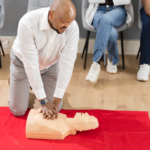The World Head Injury Awareness Day falls on March 20th every year and it looks at the number of people who suffer from a mild bump on their head to severe brain injury. The purpose of this day is to remind us of how we could reduce accidents and brain injuries if we are mindful.
Head injuries in children can be a serious concern and require prompt medical attention. Young children are more susceptible to concussion than adults are, not only because they are more likely to be active and involved in sports, but also because their brains are not yet fully developed and thus more vulnerable to injury.
A head injury is a traumatic insult to the head that may result in injury to either, the soft tissue, the bony structures or the brain itself. These injuries can occur from road accidents, falls, assaults or can be sports-related.
The aim of this day is to remind us how and where possible we could play our role in reducing accidents and brain injuries.
World Head Injury Awareness Day advocates the correct usage of helmets and seat belts, which can significantly prevent or lessen trauma to the head in accidents.
If your head suffers a fairly mild injury, in sport, a vehicle accident, or from a simple slip and fall, it can cause symptoms you don’t expect. If it has not been addressed, it may have long-term consequences.
Head injuries can inflict major damage to the central nervous system and our brain. Even minor head trauma can lead to serious complications should the correct care and treatment not be received in time. Injury to the head can result to anything from concussion, memory loss to severe paralysis and even death. Many people are partially or fully paralysed, simply due to them not wearing the appropriate head gear at the time of the accident. Interestingly, serious brain damage can occur even if the skull remains intact.
Symptoms to look out for:
- Physical symptoms like headache, nausea or vomiting, drowsiness or fatigue, problems with your speech, dizziness or changes in sleep patterns.
- Cognitive symptoms like irritability, mood swings, a feeling of tiring easily, depression, a feeling of being confused or dazed, or an inability to concentrate.
- Sensory symptoms like blurred vision, ringing in your ears, changes in taste or sensitivity to sunlight and other bright lights, or sounds, you may need medical attention including vestibular rehabilitation therapy.
When to be worried:
- If the person can’t be roused within the first 6 hours of the injury occurring.
- If there are behavioural changes i.e aggression.
- If there is a loss or decreased level of consciousness.
- If there is a severe headache with projectile (fountain) vomiting.
- If there is speech difficulty.
What to do:
- Anyone with an injury to the head needs to be monitored for at least 24 hours.
- Call for help or transport the person to the hospital if their symptoms worsen.

Mental Health Day
We all have ‘mental health’, just as we all have ‘physical health’. And just like our physical health, we can all have times when our mental health is better than others. World Mental Health Day is a day of awareness that is observed on the 10th of October every year.

SHOP
Check out our online shop! Purchase our LATEST LAUNCH, our Online Baby and Child CPR and First Aid Course and start learning from your device at home and anywhere in the world! You can also purchase our popular Family First Aid Kits and we also offer Digital Gift Vouchers for any of

Family First Aid Kit
The Family First Aid Kit has been put together by Trauma and ICU experts to ensure your family outings always give you peace of mind.

Adult CPR & First Aid Course
Adult CPR & First Aid Course Our CPR and First Aid Course will provide you with Adult CPR and standard first aid information to meet all the requirements for certification. You will learn the appropriate skills and techniques to handle a variety of situations, from unresponsive victims to serious wounds.

CPR for Professionals Course
The Resuscitation Council CPR for Professionals Course is designed for medical professionals (physiotherapists, chiropractors, homeopaths, doctors, nurses, dentists, pharmacists etc), who are registered with the Health Professions Council of South Africa. Members of the public are also allowed to attend this course. Medical professionals who need to learn or stay

Basic Life Support Course
Basic Life Support Course This American Heart Association Course is designed for medical professionals (physiotherapists, chiropractors, homeopaths, doctors, nurses, dentists, pharmacists etc), who are registered with the Health Professions Council of South Africa. Members of the public are also allowed to attend this course. UPCOMING COURSE DATES advanced life support
Burns: do you know the different types & how to treat them?
With National Burn Awareness Week (6-12 May) still top of mind, as well as the knowledge that as we approach winter our children will be increasingly exposed to heating appliances and fires, we asked Sr. Catherine Rodwell from Survival CPR to break down the different types of burns and explain




